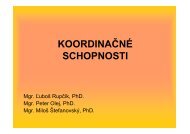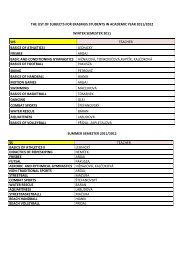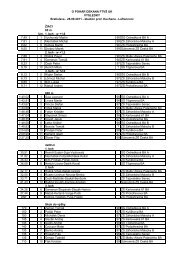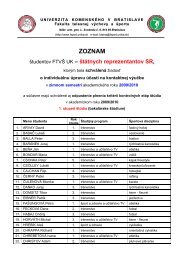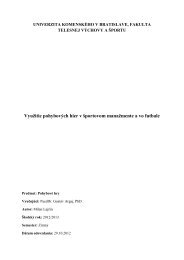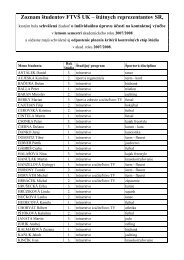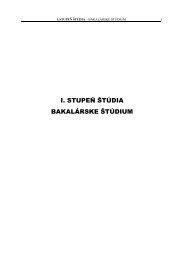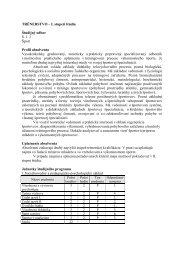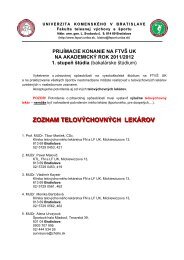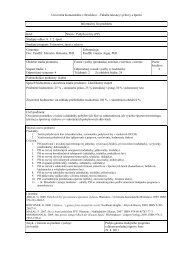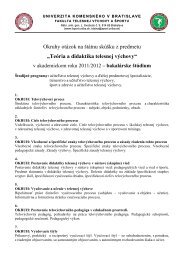acta facultatis educationis physicae universitatis comenianae
acta facultatis educationis physicae universitatis comenianae
acta facultatis educationis physicae universitatis comenianae
You also want an ePaper? Increase the reach of your titles
YUMPU automatically turns print PDFs into web optimized ePapers that Google loves.
Assessment of pedalling techniques on a bicycle depending on intensity of training load<br />
45<br />
Testing was realized in laboratory conditions on the bicycle ergometer Ergocycle that<br />
allows monitoring of tangential driving forces at frequency of 100 Hz. In the examinations<br />
we used isokinetic mode. This regime is characterized by a constant speed ensured by the<br />
special electromagnetic brake control system, which instantly adjusts resistance force acting<br />
on the pedals so that the pedalling rate remains, regardless of the pedal force, constant.<br />
For each individual we set saddle position and handlebars. Proband stood next to the<br />
saddle, picked up the leg from the ground, so that the leg was in a horizontal position.<br />
According to the upper edge, we set the seat height. Then he sat on the bike and seat height<br />
was checked or adjusted to the upper thigh leg outstretched in the position of deadlock pedal<br />
in a way so that it reached 145 to 155 degree angle (chosen limb slightly bent at the knee<br />
joint). The handlebars were adjusted to the same height as the saddle; in case of the higher<br />
subjects it was 2 – 5 cm below.<br />
Both groups completed tests in sport footwear, which were mounted to the pedal with<br />
the help of clips and baskets. To ensure standard conditions they performed tests of load in<br />
saddle. Within the actual testing the probands went through one-minute load at a frequency<br />
of 90 revolutions per minute gradually in the wattage of 100 watts, 200 watts and 300 watts.<br />
Since performance in isokinetic mode depends on the subjective effort, selected intensity<br />
load was maintained by adjusting (increasing or decreasing) of individual effort based on<br />
immediate information on performance of subjects updated after each rotation on the ergometer<br />
monitor. Finally, test subjects underwent a 10-second maximum effort load at a<br />
frequency of 90 revolutions per minute.<br />
For every one-minute load we used the software Ergocycle and this way we obtained<br />
average minimum force (N), maximum force (N) and average force (N) of 360-degree cycle<br />
of pedal revolution. When we subtracted the minimal force from the maximum force we got<br />
the difference of force (N). When the average force divided the difference we got ratio that<br />
we expressed in percentage (%) and called it equality pedalling coefficient. We compared<br />
the differences between the two groups in the equality-pedalling coefficient, with the parametric<br />
unpaired T-test.<br />
Results and discussion<br />
The results showed that the equality-pedalling coefficient of cyclists and non-cyclists<br />
at load of 100 watts did not show significant differences (Fig. 4). We assume that this could<br />
be due to too low intensity loads that cyclists hardly every use in training.<br />
At the 200-watt load, we found significant difference (p < 0.05), where the cyclists<br />
reached a coefficient of 120 ± 20 % and 138 ± non-cyclists 19 % (Fig. 4). It is this load that<br />
is essential for cyclist's training. Average performance cyclist aerobic threshold is around<br />
200 watts and the optimal frequency of revolutions around the 90 th .<br />
Load at 300 watts confirmed a significant difference (p < 0.05) when the cyclists reached<br />
the coefficient of 116 ± 17% and non-cyclists 134 ± 24 % (Fig. 4). For this load non-cyclists<br />
have to spend a huge effort and are not able to maintain it for longer time. However, for the<br />
performance cyclists this intensity presents anaerobic threshold, in which they spent most<br />
time when racing or during time trials and training. (Vogt et al., 2006, Smith et al., 2001).<br />
At 10-second maximum pedalling efforts no significant differences (p < 0.05) between cyclists<br />
and non-cyclists (Fig. 4) were confirmed.<br />
Acta Facultatis Educationis Physicae Universitatis Comenianae LII/I



